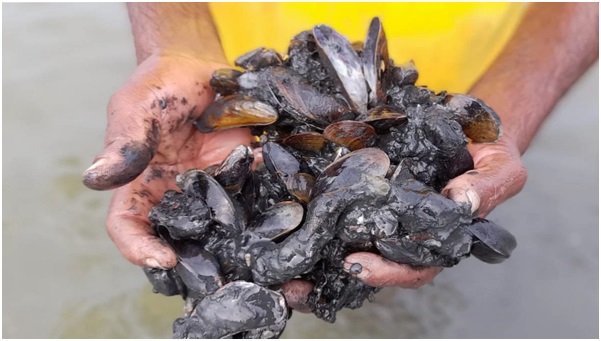NGT Investigates Removal of Invasive Mussels in Ennore-Pulicat Wetland (The Hindu)

- 07 Oct 2023
Why in the News?
The Southern Bench of the National Green Tribunal (NGT) has asked the Fisheries Department and the Tamil Nadu State Wetland Authority to file a detailed report on the removal of invasive mussel species from the Ennore-Pulicat wetland.
What is Mytella strigata?
- Mytella strigata is a moderately large mussel known for its symmetrical shell, commonly found in the middle intertidal and subtidal waters of estuaries and coastal areas.
- These mussels attach to surfaces using byssus threads.
- Appearance: Individual mussels display diverse external colours such as black, dark bluish, brown, grey, orange, and occasionally green.
- The species exhibits various shell patterns, including zigzags, spots, or concentric bands.
- Habitat and Distribution: Found in dense clusters on hard substrates and in epibenthic habitats, Mytella strigata is prevalent along the Atlantic and Pacific coasts of tropical South and Central America.
- It has also expanded its presence to regions like Taiwan, the Philippines, Singapore, the Gulf of Thailand, the west coast of India, and the southeastern United States.
- Threats: These mussels pose a threat as they spread across river bottoms, forming carpets that hinder prawns from grazing or burying themselves in the sediment.
About Pulicat Lake:
- Pulicat is an extensive brackish-to-saline lagoon with marshes and a brackish swamp on the north.
- This is the second-largest saltwater lagoon in India and a Ramsar site (internationally recognized wetland under the Ramsar Convention).
- Only 16% of the lagoon is in Tamil Nadu; the rest is in Andhra Pradesh.
- It is fed by the Araani River at the southern tip and the Kalangi River from the northwest.
- Buckingham Canal, a navigation channel, passes through the lagoon.
- On the eastern boundary of this lagoon is Shriharikota Island, which separates the lagoon from the Bay of Bengal.
- The lagoon is shallow with large areas of mudflats and sandflats.
